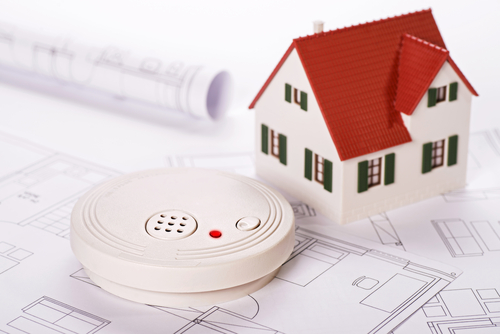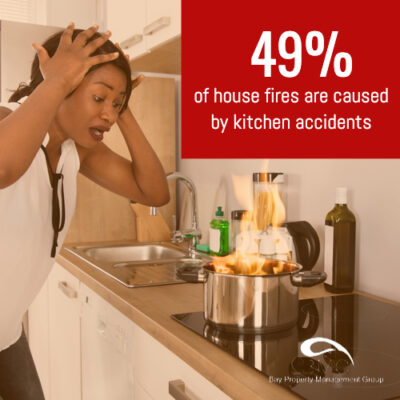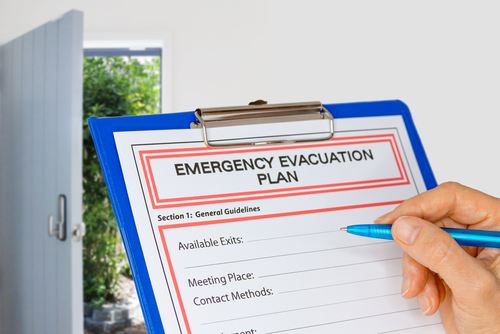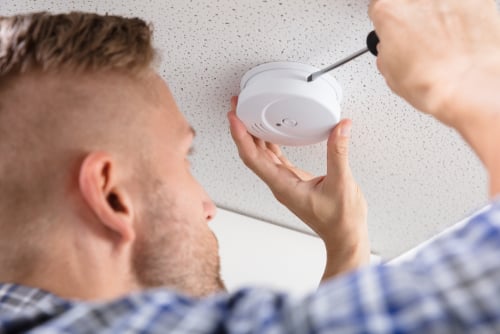It’s Fire Prevention Month, which means we’re talking about how you can protect your home from fires. It’s essential to take action steps daily to ensure you and your home are safe from a house fire. Read along as we go over statistics on house fires in the US and how you can use a home fire safety checklist to stay safe all year round.

Statistics on House Fires Across the US
House fires are more common than you may think. On average, around 358,500 homes experience a structural fire each year. In fact, in 2020, a single home fire occurred every 89 seconds, according to the National Fire Protection Association (NFPA).
Some other eye-opening fire statistics include:
- In 2020, there were 2,580 civilian deaths resulting from house fires.
- House fires caused around $8.4 billion in property damage in 2020.
- Kitchen accidents cause 49% of house fires.
- Fires can reach over 1,100°F in just 3.5 minutes.
- 20% of fires occur between 5 pm and 8 pm.
- The average home insurance claim for house fires is around $78,838.
- Although common, house fires only account for about 25% of all fires nationwide.
Now that we’ve gone over a few basic facts about house fires, let’s discuss what causes them, what equipment to keep on hand, and how to create a home fire safety checklist.
What Causes House Fires?
 Several factors may lead to house fires. However, there’s one main cause–cooking. In fact, Thanksgiving is the peak day for kitchen fires resulting from cooking.
Several factors may lead to house fires. However, there’s one main cause–cooking. In fact, Thanksgiving is the peak day for kitchen fires resulting from cooking.
Research shows that most house fires start in the kitchen, which is where most fire injuries occur. Kitchen fires are especially prevalent in multi-family buildings, as around 69% of kitchen fires started in apartment settings in 2020.
As such, it’s crucial to be cautious in the kitchen. Never leave your stove unattended; keep your stove and oven area clear of any flammable materials. Additionally, even if you’re using the oven for baking, roasting, or broiling, stay in the kitchen and use a timer to remind you when it’s done.
Now, let’s go over some other causes of house fires. Some of the leading causes of house fires include:
- Heating Equipment
- Smoking Materials
- Electrical or Lighting Equipment
- Intentional Fire Setting
Heating Equipment
If you’re using a space heater, ensure you get one that can turn off automatically when overheated, and keep it at least three feet away from flammable items. Additionally, it’s important to have your furnace and chimney professionally cleaned and inspected yearly.
Contact your local property management company in Philadelphia if you need help inspecting your property for fire safety.
Smoking Materials
Another cause of house fires is using smoking materials indoors, like cigarettes or lighters. As such, it’s crucial to use caution when smoking. Always try to smoke outside, especially in a rental home, as most rentals don’t allow indoor smoking.
Additionally, if you smoke, ensure cigarettes are put out before walking away or throwing them in the trash. You can use water or sand to ensure cigarette butts are completely out.
Electrical or Lighting Equipment
When it comes to electrical and lighting systems, it’s crucial to have them inspected regularly to ensure they’re working correctly. Also, if you have any electrical work done, make sure a qualified electrician does it.
Additionally, watch for any signs of damaged or defective wiring. For instance, if there’s any discoloration around outlets or visibly damaged wiring, make sure you get it inspected and fixed immediately.
Intentional Fire Setting
Intentional fires are caused by a “deliberate misuse of a heat source of a fire of an incendiary nature,” according to NFPA. Some examples may include large fires resulting from fireworks, a vehicle fire, or an outside bonfire. As such, it’s crucial to use caution when lighting fires and working with fireworks.
Emergency Equipment to Keep on Hand for Fire Safety
Each household needs a few essential supplies to prevent or detect house fires. The main fire safety equipment tools include:
- Smoke Alarms
- Fire Extinguishers
- Carbon Monoxide Detectors
- Sprinklers
Smoke Alarms
It’s essential to have smoke alarms throughout your home to detect abnormal amounts of smoke or gases in the air. Install smoke alarms on each level of your home and in each bedroom. Additionally, test your smoke alarms monthly to ensure they’re working correctly.
Fire Extinguishers
Another tool that you should have in your home or rental is a fire extinguisher. However, knowing how to use one is important. So consider getting training or practice, since you won’t have time to read the directions during an emergency.
Carbon Monoxide Detectors
Install carbon monoxide detectors in your home to protect your household against toxic gases. Carbon monoxide is a colorless, odorless gas that results from the incomplete burning of fuels. Even small amounts of this gas can poison or kill a person after prolonged exposure.
Sprinklers
Once you’ve been alerted by your smoke alarm that there’s a fire, a sprinkler system can prevent spreading the fire before the fire department gets to your home. Additionally, sprinklers can decrease the chance that deadly gases and fire smoke will reach your household.
Prevent Fires with This Home Fire Safety Checklist
Coming up with a checklist of prevention methods and action steps for fire safety is a must for all renters and homeowners. After all, you don’t want to find yourself in a situation where you’ve accidentally started a fire within your home and have to evacuate. So follow this home fire safety checklist to protect your home from fires.
Home Fire Safety Checklist:

- Smoke Alarms: Install smoke alarms in your home or rental and test them regularly.
- Fire Escape Plan: Formulate a fire escape plan and rehearse it with your family or roommates.
- Be Aware When Cooking: Use caution when using the stove, oven, or microwave. Avoid wearing loose clothing near open flames and keep dishcloths, food wrappers, and other flammable items away from the stove.
- No Smoking: Don’t smoke inside your home or apartment. Most rental properties prohibit smoking, anyway.
- Be Cautious with Candles: Ensure candles are extinguished before leaving a room, and be aware of flammable items near your candles.
- Space Heaters: Use space heaters cautiously and keep them away from flammable materials.
- Check Electrical Outlets: Malfunctioning electrical outlets can start fires, so ensure none of the outlets in your home are loose and can still hold a plug.
- Kid Fire Safety: Keep lighters and matches out of kids’ reach to avoid starting a fire and putting your house or child in danger.
- Electronics: Be careful when plugging in electronics. Use a surge protector to protect your devices and prevent the overload of an outlet.
- Declutter: Too much stuff around your home or apartment can be a fire hazard alone. Clutter makes it easier for fires to spread and can be an obstacle that prevents you from safely leaving your home in case of a fire.
If you don’t have a fire escape plan or use fire safety while cooking, today is a great day to start. It’s crucial to develop a plan of action with your family or roommates in case a fire starts in your home or apartment. Use this home fire safety checklist as an example, and discuss fire safety with your household. Most importantly, ensure everyone is taking preventative measures while cooking, using electronics, or lighting candles.
Keep Your Rentals Protected with Property Management
Despite your personal efforts to keep your rental homes safe, it’s essential to keep up with fire prevention all year round. Yearly inspections, testing smoke alarms, and communicating with tenants about fire safety is crucial for all landlords. Unfortunately, however, not everyone has the time for it.
Keep Your Rentals Safe with professional management
Luckily, if you have a property management team, you don’t have to spend time going from rental to rental to check up on fire safety measures. Bay Property Management Group offers comprehensive rental management services for busy landlords in Baltimore, Philadelphia, Northern Virginia, and Washington, DC.
Whether you have one or one hundred rental properties, BMG can help with tenant screening, maintenance, move-in and move-out reports, rent collection, and more. Contact BMG today if you’re looking for a full-service team to manage your rentals.

